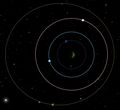Difference between revisions of "Jool/zh-cn"
| Line 20: | Line 20: | ||
|} This glitch, while most common on Jool, is not unique to Jool, and can even be experienced on Kerbin in extreme situations; for example, going on EVA from a high speed SpacePlane as it takes off can occasionally cause this. If you do experience this outside of Jool, it is very difficult to replicate, which is why recordings of this are so rare. | |} This glitch, while most common on Jool, is not unique to Jool, and can even be experienced on Kerbin in extreme situations; for example, going on EVA from a high speed SpacePlane as it takes off can occasionally cause this. If you do experience this outside of Jool, it is very difficult to replicate, which is why recordings of this are so rare. | ||
| − | == | + | == 时间加速 == |
{{:Jool/RefFrame}} | {{:Jool/RefFrame}} | ||
Revision as of 05:56, 19 June 2013
Jool是一颗气态巨行星,是 Kerbol 星系中的第六颗行星。它实际上就是 Kerbal 太空计划中的木星。除 Kerbol 之外,在星系中所有天体中,Jool 的直径和质量都排名第一。虽然它距离 Kerbin 很远,难以到达,它还是由于其自身复杂的五卫星体系成为极具吸引力的航天探索目标,它的五颗卫星包括:Laythe、Vall、Tylo、Bop和Pol。
Atmosphere
|
Although Jool has a radius ten times greater than Kerbin, its atmosphere begins just twice as high (138.2 km). It is extremely dense, well suited for aerobraking from a high-speed interplanetary intercept. Orbiting just outside the atmosphere will give you a period of 94.7437 minutes, and a speed of 6,785 m/s. You typically do not need to go lower than 100 km to aerobrake. In general, the atmospheric pressure on Jool at an altitude expressed in meters is: Closer to the surface, the physics of the game start to break down. Due to its extremely thick atmosphere, terminal velocity is so low that lighter spacecraft will not even need parachutes or retrorockets. It is not impossible to land on its solid surface, though spacecraft are inevitably and invariably devoured by the Kraken. If the craft is very small, it may survive the Kraken, but the parts will explode once they are 100m below the surface. The message "... collided with Cloud" will display in the mission summary. If a Kerbonaut is put on EVA he will not be destroyed, making one-way sacrificial landings possible. However, as seen near the end of this video, the Kerbonaut will start to glitch out and shake uncontrollably. This only happens if you're on time warp 4. The game will later glitch and cut to a black screen with the altimeter going through numbers rapidly. Unless you restart the game, Kerbin's atmosphere will be missing. |
时间加速
| 时间加速 | 最低海拔 |
|---|---|
| 1× | 所有 |
| 5× | 200 000 米 (高于大气上限) |
| 10× | 200 000 米 (高于大气上限) |
| 50× | 200 000 米 (高于大气上限) |
| 100× | 200 000 米 (高于大气上限) |
| 1 000× | 300 000 米 |
| 10 000× | 600 000 米 |
| 100 000× | 1 200 000 米 |
Natural Satellites
 The ocean moon Laythe, about to transit Jool. Jool has five natural satellites, each with an orbit well-aligned with Jool's orbital plane:
Laythe, Vall, and Tylo are in a Laplace resonance, with orbital periods of 1:2:4 respectively. Despite the fact that the moons can easily eclipse both each other and Jool, they do not. Synchronous Orbits around any of the Joolian moons are impossible, as they all lie outside the Sphere of Influence of the moons, as is common with tidally locked bodies. |
Gallery
- Screenshot540.png
Low orbit over Jool.
- Screenshot73.png
A Probe with winglets to steer. Note that as you descend deeper into the atmosphere, it gets harder to move at all, rendering RCS and winglets useless.
- Screenshote4141412.png
A view of Laythe, Vall, and Tylo during an aerobraking on Jool.
Trivia
- Jool has roughly the same equatorial radius as the planets Earth and Venus.
- The sunsets and sunrises on Jool are a shade of yellowish brown.
- Like Jool, Jupiter's nearest three moons (Io, Europa, and Ganymede) have a Laplace resonance of 1:2:4.
Changes
- Added a new, more distant moon named Pol.
- Initial Release







